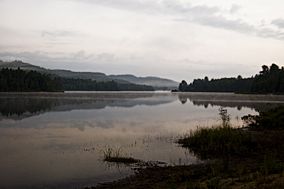Papineau-Labelle Wildlife Reserve facts for kids
Quick facts for kids Papineau-Labelle Wildlife Reserve |
|
|---|---|
| Réserve faunique de Papineau-Labelle | |

Ernest Lake at dawn
|
|
| Location | Papineau Regional County Municipality / Antoine-Labelle Regional County Municipality, Quebec, Canada |
| Nearest city | Gatineau |
| Area | 1,628 km2 (629 sq mi) |
| Established | 1971 |
| Governing body | Sépaq |
The Papineau-Labelle Wildlife Reserve is a special place in the Laurentian Mountains of Quebec, Canada. It stretches across two regions: the Laurentides and Outaouais. This reserve is a huge natural area. It offers many chances for outdoor fun. It also helps protect local wildlife.
For many years, from the late 1800s to the mid-1900s, the area was used for logging. This means trees were cut down for wood. Even though some logging still happens, the reserve was created in 1971. Its main goal was to let people enjoy nature. It also aimed to protect animals and their homes. The reserve works hard to keep its natural resources healthy. It helps wildlife and fish grow. For example, it sets up special places for fish to lay eggs. It also creates tree groves and nesting boxes for birds.
The reserve is named after two important people from Quebec's history. Louis-Joseph Papineau (1786–1871) was a famous speaker. He was a leader of the Patriots in 1837. Antoine Labelle (1833–1891) was a pastor. He strongly encouraged people to settle in the Upper Laurentians.
In 2008, a newspaper called the Montreal Gazette described the Papineau-Labelle Reserve as "magnificent." They even said it was one of the top 10 wild spots in Quebec to experience.
Contents
Exploring the Reserve's Geography
This huge reserve covers parts of nine different towns and one territory. It is home to 763 lakes and 42 streams. Some mountains here reach up to 500 meters (about 1,640 feet) high. The reserve is also where two rivers begin. The Petite-Nation River flows south into the Ottawa River. The Sourd River flows west and joins the Lièvre River.
Notable Lakes to Discover
Many beautiful lakes are found within the reserve. Some of the larger and more well-known ones include:
- Echo Lake
- Ernest Lake
- Joinville Lake
- Lock Lake (Lac de l'Écluse)
- Lake of Mallows (Lac des Mauves)
- Marie-Lefranc Lake
- Montjoie Lake
- Paul Lake
- Preston Lake
- Saint-Denis Lake
- Lake of Seven Brothers (Lac des Sept Frères)
- Sourd Lake
Wildlife and Plants of the Reserve
The Papineau-Labelle Reserve is in a special area. It is where eastern forests meet boreal forests. This means you will see a mix of trees. The main trees are sugar maple and yellow birch. You can also find other softwoods like fir, spruce, pine, cedar, and hemlock. Other hardwoods include red oak, beech, linden, elm, and ash.
Amazing Animals to Spot
Many different animals live here. You might see white-tailed deer or even a large moose. Black bears and wolves also call this reserve home. Smaller animals like beavers, foxes, and snowshoe hares are common. Birdwatchers can look for ruffed grouse and spruce grouse.
Fish Species in the Waters
The lakes in the reserve are full of fish. Popular species for fishing include brook trout and lake trout. You might also find splake, smallmouth bass, walleye, and northern pike.
Fun Activities for Visitors
The Papineau-Labelle Wildlife Reserve offers activities all year long. There is something for everyone!
Year-Round Adventures
- Fishing: Try to catch some of the many fish species.
- Hunting: Hunting is allowed in certain areas with a permit.
- Canoe Camping: Paddle across lakes and camp by the water.
- Hiking: Explore the many trails on foot.
- Wild Berry Picking: Gather delicious berries when in season.
- Wildlife and Bird Viewing: Watch for animals and birds in their natural homes.
- Cross-Country Skiing: Enjoy the snowy trails in winter.
- Dogsledding: Experience a thrilling ride with a team of dogs.
- Snowmobiling: Ride snowmobiles on designated trails.
Remember, you need permits and must pay fees for these activities.
Where to Stay
The reserve has different places for visitors to stay. You can choose from cozy cabins or rustic shelters. There are also huts and campsites. Some campsites have basic services, while others are more wild (backcountry).

